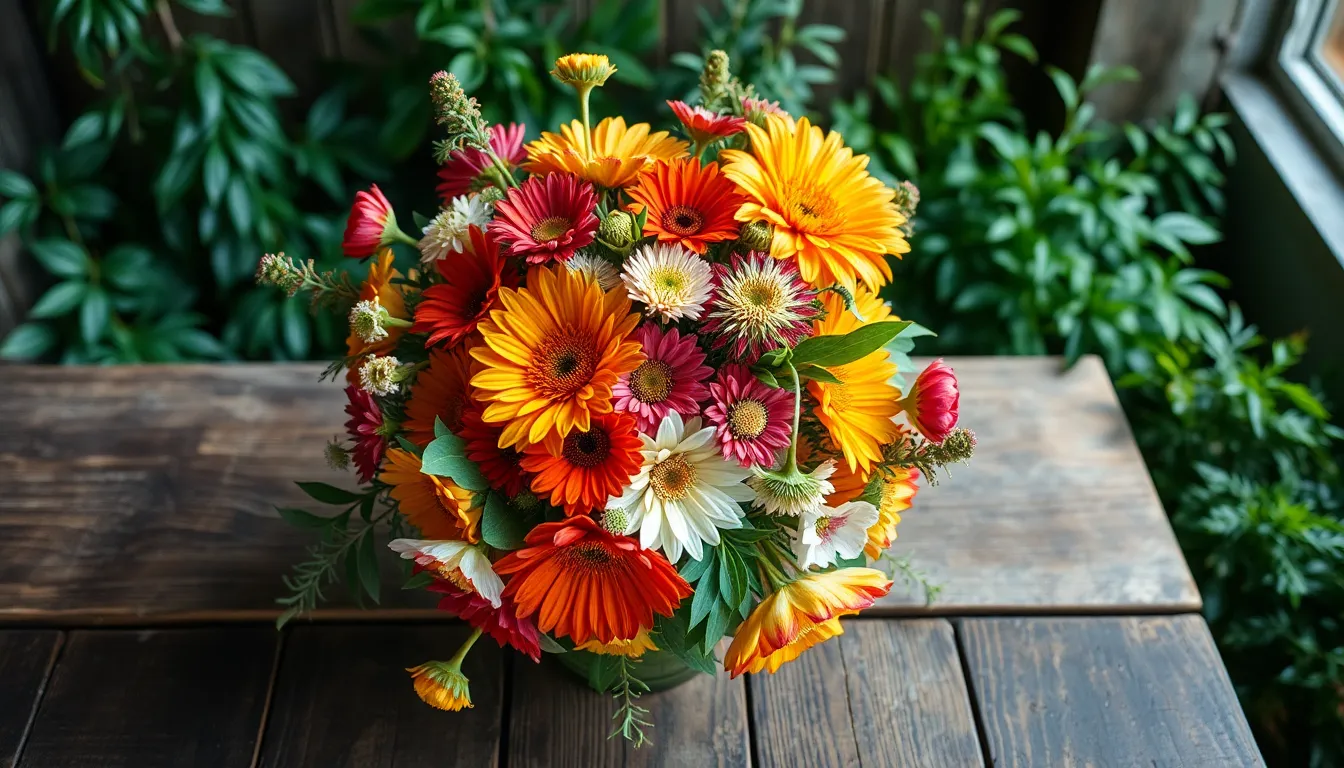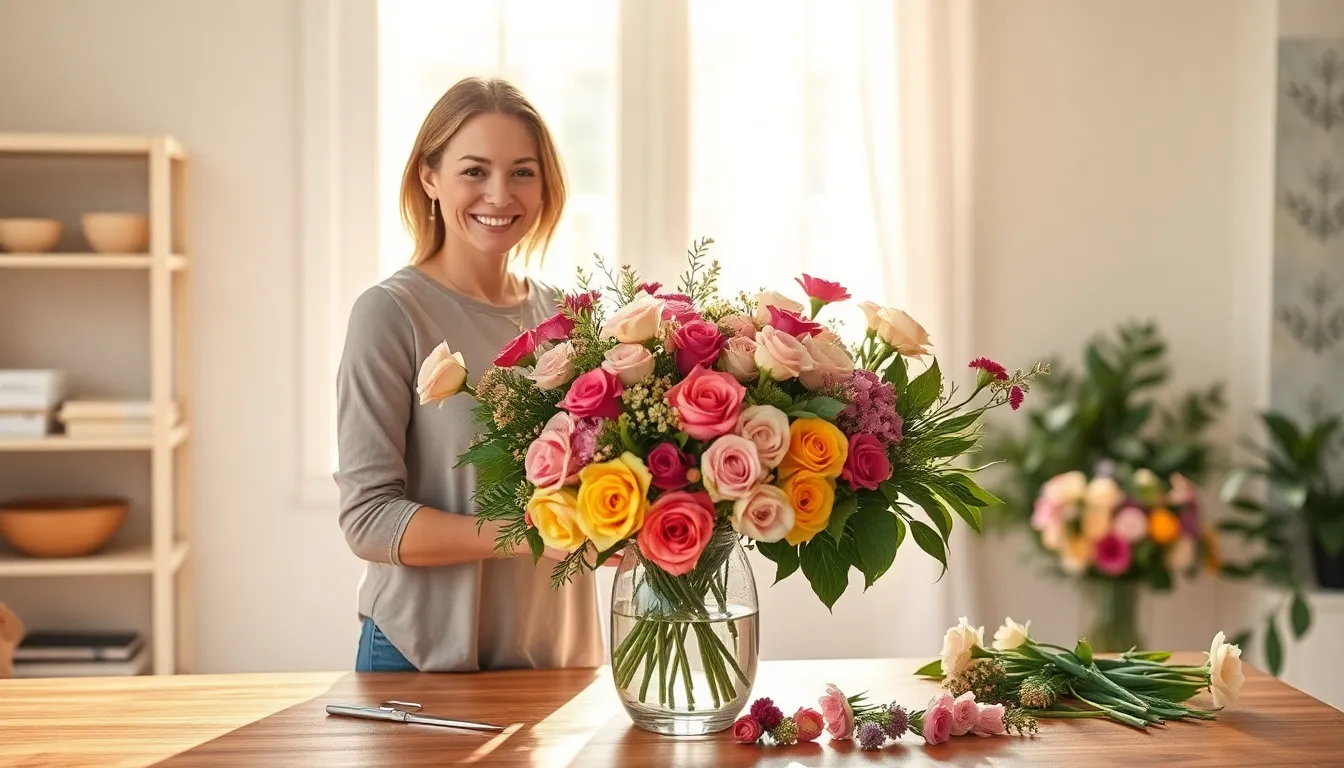Table of Contents
ToggleFlowers have a magical way of brightening up any space, but let’s be honest—arranging them can feel like trying to solve a Rubik’s Cube blindfolded. The right flower arrangement transforms a simple bouquet into a stunning centerpiece that leaves everyone wondering if a professional florist secretly worked their magic.
Overview of Flower Arrangements
Flower arrangements transform spaces through their aesthetic appeal. They require an understanding of color, texture, and design principles. Various styles exist, catering to different occasions and preferences.
Classic arrangements often feature traditional flowers like roses, lilies, and daisies. Contemporary styles may incorporate exotic blooms or unique foliage. Seasonal arrangements use flowers in peak bloom, which enhances visual impact.
Creating a balanced composition involves considering height, symmetry, and color harmony. Flowers should be grouped based on their size, ensuring a cohesive look. The choice of vase or container also influences the arrangement’s overall style.
Choose a focal point to guide the arrangement. This element often draws the viewer’s eye and sets the tone for the design. Working with different flower types adds depth, mixing shapes and heights for interest.
Maintenance plays a crucial role in the longevity of flower arrangements. Regularly changing the water and trimming stems ensures freshness. Additionally, placing arrangements in proper lighting extends their beauty.
Incorporating personal touches, like specific colors or meaningful flowers, enhances the emotional significance of arrangements. These details create a connection between the arrangement and its setting.
Whether for home decor, events, or gifts, effective flower arrangements bring life to any space. Mastering the art of arrangement unlocks the potential for creating stunning floral displays.
Types of Flower Arrangements

Understanding various flower arrangement types enhances one’s ability to create stunning displays. Each type serves specific purposes and occasions.
Bouquets
Bouquets consist of flowers arranged in a handheld style. A variety of blooms create unique combinations, from seasonal selections to specialized themes. Common types include bridal bouquets and gifting bouquets, each tailored for specific events. Consider size because larger bouquets often make a bolder statement. Fleurists often use wrapping materials, adding elegance through textures or colors. Seasonal flowers provide a fresh touch, incorporating vibrant hues to match particular themes or celebrations.
Centerpieces
Centerpieces anchor tables, drawing attention in dining and event settings. They vary in height and style, influencing the overall atmosphere. Low centerpieces promote conversation across tables, while tall arrangements create visual impact. Implementing a mix of textures adds depth, making the floral display more engaging. Notable elements include candles or decorative accents, enhancing the centerpiece’s appeal. Selecting flowers in hues complementing the table setting ensures cohesion among decor elements, enriching the dining experience.
Wreaths
Wreaths combine flowers and foliage into circular designs. They symbolize eternity, showcasing beauty throughout various seasons. Usage spans from holiday decorations to tributes during memorials. Seasonal wreaths highlight blooms and greenery appropriate for each time of year. Adding personal touches, such as ribbons, enhances individuality. Thick, lush designs convey fullness, while minimalist approaches focus on specific blooms, emphasizing simplicity. Transforming spaces, wreaths evoke emotions and memories, serving as eye-catching decorations.
Techniques for Creating Flower Arrangements
Mastering techniques for flower arrangements enhances visual appeal and emotional impact. Successful arrangements rely on principles like color theory and balance.
Color Theory
Understanding color theory is essential for creating harmonious arrangements. Colors evoke emotions and set the mood. Complimentary colors, such as purple and yellow, create striking contrasts, while analogous colors, like blue and green, offer soothing effects. Selecting a dominant color unifies the arrangement, ensuring visual cohesion. Seasonal flowers often reflect natural color palettes, aligning with specific themes. Incorporating neutral tones like white or green can add depth without overwhelming other colors, allowing the focal flowers to shine.
Balance and Proportion
Achieving balance and proportion makes arrangements aesthetically pleasing. Symmetrical arrangements often convey formality and elegance, while asymmetrical designs create a dynamic, modern look. Height variation among flowers contributes to visual interest. Taller stems might be used at the back, with shorter blossoms in front to draw the eye. Maintaining proportion involves considering the size of the vase and the surrounding space. A flower arrangement should complement its environment, neither dominating nor disappearing within it. Consistency in flower quantity across sections aids in achieving overall balance.
Tips for Flower Arrangement Maintenance
Maintaining flower arrangements ensures their beauty and longevity. Change the water every two to three days. Fresh water prevents bacterial growth, which can cause wilting. Trim the stems at an angle before placing them in a vase. Angled cuts increase the surface area for water absorption, extending the flowers’ lifespan.
Keep arrangements out of direct sunlight. Excess light can cause flowers to dehydrate quickly. Instead, select a cool location that promotes longevity. Remove wilted or dying flowers promptly. This practice prevents decay from spreading to healthy blooms.
Add floral preservatives to the water. These solutions provide nutrients that nourish flowers. Using preservatives can significantly enhance the lifespan of arrangements. Monitor the room temperature and humidity levels. Extreme temperatures can stress flowers, leading to premature wilting.
Change the arrangement’s water if it becomes cloudy. Cloudy water indicates bacteria development. Replenishing the water ensures freshness. Also, check the leaves regularly for any decay. Healthy foliage contributes to the overall aesthetics of the arrangements.
Rotate the vase occasionally. This technique allows each side of the arrangement to receive equal light exposure, enhancing even growth. When preparing an arrangement, make sure to select seasonal flowers. Seasonal blooms tend to last longer and remain vibrant.
Use clean tools while handling flowers. Bacteria from unclean tools can adversely affect the arrangement. Lastly, enjoy your flower arrangements! Observing their development while following these care tips adds to the overall experience.
Seasonal Flower Arrangements
Seasonal flower arrangements offer unique beauty reflective of their time of year. Spring evokes freshness with bright daffodils and tulips, creating lively displays perfect for celebrations. Summer brings vibrant sunflowers and hydrangeas, filling spaces with warmth and color. Autumn showcases rich hues of chrysanthemums and dahlias, ideal for cozy gatherings. Winter arrangements can feature elegant poinsettias and evergreen branches, providing a festive touch during holidays.
Choosing seasonal flowers enhances sustainability and supports local growers. Local florists often offer varieties that bloom during specific months, ensuring freshness and reducing transportation emissions. Floral choices change with availability, making arrangements not only visually appealing but also environmentally conscious.
Different seasons prompt various arrangement styles. Spring often calls for light, airy designs, while summer favors bold and abundant displays. In autumn, arrangements tend to focus on earthy tones with a rustic feel. Winter arrangements typically emphasize elegance and simplicity, reflecting the serene beauty of the colder months.
Techniques vary with seasonal offerings. Layering flowers adds depth to spring bouquets, while bold colors in summer arrangements capture the eye. Harvest-inspired designs in autumn arrangements incorporate textures like berries and twigs, enhancing their rustic charm. Minimalistic winter arrangements frequently use greenery alongside a few striking blooms for a refined look.
Seasonal flower arrangements not only energize living spaces but also evoke emotions tied to specific times of the year. By selecting flowers that flourish during each season, arrangements take on a unique character, celebrating nature’s cycles and providing joy in any environment.
Flower arrangements hold the power to transform any space into a visual delight. By understanding the principles of color, texture, and design, anyone can create stunning displays that resonate emotionally. Whether it’s a classic bouquet for a special occasion or a contemporary centerpiece for a casual gathering, the right arrangement can elevate the atmosphere.
Caring for these arrangements is just as important as crafting them. Simple maintenance techniques ensure that flowers remain vibrant and beautiful for longer. Embracing seasonal blooms not only enhances aesthetics but also supports local growers and promotes sustainability. Ultimately, the joy of creating and maintaining flower arrangements brings life and beauty to any environment.





